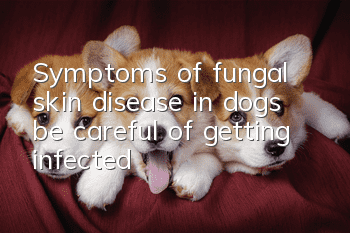Symptoms of fungal skin disease in dogs, be careful of getting infected

Symptoms of fungal skin diseases in dogs
1. Microsporum canis:It is found all over the world. It is responsible for more than 70% of canine ringworm and can be infected by a variety of animals and people. . The main symptom is the formation of small, round-like scabs on the skin surface. This focal scab skin lesion can appear on any part of the dog, but is most common on the ears, face, neck and tail. This disease does not cause hair loss and often goes undetected when the lesions are small, especially in long-haired dogs. Microsporum canis mainly causes tinea capitis in humans.
2. Microsporum gypsum:
It lives in soil all over the world and can cause skin mycosis in dogs and other animals and humans. The onset of this disease is rapid and the damage is severe. The location of its occurrence is similar to that of Microsporum canis. In addition to round ringworm, it sometimes causes large-scale skin lesions. The coat of the lesion falls off, and dandruff and scabs appear. When secondary bacterial infection occurs, exudative suppuration occurs locally. It can last for months or even years after it becomes chronic.
3. Microsporum audouinii and Trichophyton mentagrophytes:
These two species of bacteria are rare causes of canine skin mycosis. These two molds can also infect people. The former mainly causes tinea capitis in children, and the latter is the main pathogen of athlete's foot in the United States. Dogs usually become infected through contact with sick people.
Causes of canine fungal skin diseases
1. The occurrence of canine skin mycosis is related to climate, age and physical constitution. For example, hot and humid climates have a higher incidence rate, and young animals have a higher incidence rate. Adult animals are susceptible, and malnourished and weak animals are more susceptible than nutritionally strong animals.2. In clinical practice, long-term use of large doses of stimulation causes dogs to have reduced resistance, and they are also susceptible to this disease.
3. Pathogens According to clinical statistics, 5 types of molds have been found to cause skin mycosis in dogs. They are: Microsporum canis, Microsporum gypseum, Trichophyton mentagrophyton, and Microsporum audouin. bacteria and Microsporum proteus. Among them, Microsporum canis is the most common, followed by Microsporum gypseum, Trichophyton mentagrophytes and Microsporum audouinii. Microsporum proteus is only found in a few countries, such as Australia, and its incidence is low.
Popular characteristics of fungal skin diseases in dogs
1. Mold has strong vitality and resistance. It can parasitize animals and plants or be spread in the air with dust, giving many opportunities for transmission.2. Skin mold enters the skin through scratches.
3. Infection is mainly through direct contact, but indirect infection can also be caused by contact with contaminated utensils, combs, scissors, mats, etc.
4. Animals and humans and dogs can be infected with each other.
Random articles
- What do dogs eat to protect their stomach? It is important to protect their stomach and treat gastrointestinal diseases in dogs.
- How to tell if your dog is fat? Is your dog overweight?
- Will your dog catch a cold if you blow the air conditioner? What should you do if your dog catches a cold if you blow the air conditioner?
- What should you pay attention to when your dog drinks water? Don’t be careless when it comes to your dog’s drinking water.
- The dog's mouth bites and shakes. Why does the dog's mouth occasionally shake and bite?
- How to cut a dog's hair? Do you know how to cut a dog's hair correctly?
- Can dogs eat raw eggs? Why can’t dogs eat egg whites?
- Common Dog Problems in Summer How to Deal with Different Dog Problems
- How to keep dogs away from skin diseases. If you do this, will you see if your dog will still be infected with skin diseases?
- What causes anorexia in dogs? Dogs will become anorexic due to lack of exercise. Hounds run at least 5KM every day.



